
FEATURES
D
LOW OFFSET: 5mV (max)
D
LOW I
B
: 10pA (max)
D
HIGH BANDWIDTH: 6.5MHz
D
RAIL-TO-RAIL INPUT AND OUTPUT
D
SINGLE SUPPLY: +2.3V to +5.5V
D
SHUTDOWN: OPAx373
D
SPECIFIED UP TO +125
∞
C
D
MicroSIZE PACKAGES: SOT23-5, SOT23-6,
and SOT23-8
APPLICATIONS
D
PORTABLE EQUIPMENT
D
BATTERY-POWERED DEVICES
D
ACTIVE FILTERS
D
DRIVING A/D CONVERTERS
DESCRIPTION
The OPA373 and OPA374 families of operational
amplifiers are low power and low cost with excellent
bandwidth (6.5MHz) and slew rate (5V/
µ
s). The input
range extends 200mV beyond the rails and the output
range is within 25mV of the rails. Their speed/power ratio
and small size make them ideal for portable and
battery-powered applications.
The OPA373 family includes a shutdown mode. Under
logic control, the amplifiers can be switched from normal
operation to a standby current that is less than 1
µ
A.
The OPA373 and OPA374 families of operational
amplifiers are specified for single or dual power supplies
of +2.7V to +5.5V, with operation from +2.3V to +5.5V. All
models are specified for -40
∞
C to +125
∞
C.
1
2
3
5
4
V+
-
IN
Out
V
-
+IN
OPA374
SOT23-5
1
2
3
4
8
7
6
5
Enable
V+
OUT
NC
(2)
NC
(2)
-
IN
+IN
V
-
OPA373
SO-8
1
2
3
4
8
7
6
5
NC
(2)
V+
OUT
NC
(2)
NC
(2)
-
IN
+IN
V
-
OPA374
SO-8
1
2
3
4
5
10
9
8
7
6
V+
OUT B
-
IN B
+IN B
Enable B
OUT A
-
IN A
+IN A
V
-
Enable A
OPA2373
MSOP-10
A
B
1
2
3
4
8
7
6
5
V+
OUT B
-
IN B
+IN B
OUT A
-
IN A
+IN A
V
-
OPA2374
SO-8, SOT23-8
A
B
1
2
3
4
5
6
7
14
13
12
11
10
9
8
OUT D
-
IN D
+IN D
V
-
+IN C
-
IN C
OUT C
OUT A
-
IN A
+IN A
V+
+IN B
-
IN B
OUT B
OPA4374
SO-14, TSSOP-14
A
D
B
C
1
2
3
6
5
4
V+
Enable
-
IN
Out
V
-
+IN
OPA373
SOT23-6
(1)
A7
5
(1) Pin 1 of the SOT23-6 is determined by orienting the package marking as shown.
(2) NC indicates no internal connection.
OPA373, OPA2373
OPA374
OPA2374, OPA4374
SBOS279D - SEPTEMBER 2003 - REVISED DECEMBER 2004
6.5MHz, 585
µ
A, Rail-to-Rail I/O
CMOS Operational Amplifier
PRODUCTION DATA information is current as of publication date. Products
conform to specifications per the terms of Texas Instruments standard warranty.
Production processing does not necessarily include testing of all parameters.
www.ti.com
Copyright
2003-2004, Texas Instruments Incorporated
Please be aware that an important notice concerning availability, standard warranty, and use in critical applications of Texas Instruments
semiconductor products and disclaimers thereto appears at the end of this data sheet.
All trademarks are the property of their respective owners.

OPA373, OPA2373
OPA374
OPA2374, OPA4374
SBOS279D - SEPTEMBER 2003 - REVISED DECEMBER 2004
www.ti.com
2
PACKAGE/ORDERING INFORMATION
(1)
PRODUCT
PACKAGE-LEAD
PACKAGE
DESIGNATOR
SPECIFIED
TEMPERATURE
RANGE
PACKAGE
MARKING
ORDERING
NUMBER
TRANSPORT
MEDIA, QUANTITY
Shutdown
OPA373
SOT23-6
DBV
-40
∞
C to +125
∞
C
A75
OPA373AIDBVT
Tape and Reel, 250
OPA373AIDBVR
Tape and Reel, 3000
OPA373
SO-8
D
-40
∞
C to +125
∞
C
OPA373A
OPA373AID
Rails, 100
OPA373AIDR
Tape and Reel, 2500
OPA2373
MSOP-10
DGS
-40
∞
C to +125
∞
C
AYO
OPA2373AIDGST
Tape and Reel, 250
OPA2373AIDGSR
Tape and Reel, 2500
Non-Shutdown
OPA374
SOT23-5
DBV
-40
∞
C to +125
∞
C
A76
OPA374AIDBVT
Tape and Reel, 250
OPA374AIDBVR
Tape and Reel, 3000
OPA374
SO-8
D
-40
∞
C to +125
∞
C
OPA274A
OPA374AID
Rails, 100
OPA374AIDR
Tape and Reel, 2500
OPA2374
SOT23-8
DCN
-40
∞
C to +125
∞
C
ATP
OPA2374AIDCNT
Tape and Reel, 250
OPA2374AIDCNR
Tape and Reel, 3000
OPA2374
SO-8
D
-40
∞
C to +125
∞
C
OPA2374A
OPA2374AID
Rails, 100
OPA2374AIDR
Tape and Reel, 2500
OPA4374
SO-14
D
-40
∞
C to +125
∞
C
OPA4374A
OPA4374AID
Rails, 58
OPA4374AIDR
Tape and Reel, 2500
OPA4374
TSSOP-14
PW
-40
∞
C to +125
∞
C
OPA4374A
OPA4374AIPWT
Tape and Reel, 250
OPA4374AIPWR
Tape and Reel, 2500
(1) For the most current package and ordering information, see the Package Option Addendum located at the end of this datasheet.
ABSOLUTE MAXIMUM RATINGS
(1)
Supply Voltage
+7.0V
. . . . . . . . . . . . . . . . . . . . . . . . . . . . . . . . . . . . .
Signal Input Terminals, Voltage(2)
-0.5V to (V+) + 0.5V
. . . . . . . . .
Current(2)
±
10mA
. . . . . . . . . . . . . . . . . . .
Output Short-Circuit(3) Continuous
. . . . . . . . . . . . . . . . . . . . . . . . .
Operating Temperature
-55
∞
C to +150
∞
C
. . . . . . . . . . . . . . . . . . . . .
Storage Temperature
-65
∞
C to +150
∞
C
. . . . . . . . . . . . . . . . . . . . . . .
Junction Temperature
+150
∞
C
. . . . . . . . . . . . . . . . . . . . . . . . . . . . . . .
Lead Temperature (soldering, 10s)
+300
∞
C
. . . . . . . . . . . . . . . . . . . .
(1) Stresses above these ratings may cause permanent damage.
Exposure to absolute maximum conditions for extended periods
may degrade device reliability. These are stress ratings only, and
functional operation of the device at these or any other conditions
beyond those specified is not implied.
(2) Input terminals are diode-clamped to the power-supply rails.
Input signals that can swing more than 0.5V beyond the supply
rails should be current-limited to 10mA or less.
(3) Short-circuit to ground, one amplifier per package.
This integrated circuit can be damaged by ESD. Texas
Instruments recommends that all integrated circuits be
handled with appropriate precautions. Failure to observe
proper handling and installation procedures can cause damage.
ESD damage can range from subtle performance degradation to
complete device failure. Precision integrated circuits may be more
susceptible to damage because very small parametric changes could
cause the device not to meet its published specifications.

OPA373, OPA2373
OPA374
OPA2374, OPA4374
SBOS279D - SEPTEMBER 2003 - REVISED DECEMBER 2004
www.ti.com
3
ELECTRICAL CHARACTERISTICS: V
S
= +2.7V to +5.5V
Boldface limits apply over the specified temperature range, T
A
= -40
∞
C to +125
∞
C.
At TA = +25
∞
C, RL = 10k
connected to VS/2, and VOUT = VS/2, unless otherwise noted.
OPA373, OPA2373, OPA374,
OPA2374, OPA4374
PARAMETER
CONDITIONS
MIN
TYP
MAX
UNIT
OFFSET VOLTAGE
Input Offset Voltage
V
OS
V
S
= 5V
1
5
mV
over Temperature
6.5
mV
Drift
dV
OS
/dT
3
µ
V/
∞
C
vs Power Supply
PSRR
V
S
= 2.7V to 5.5V, V
CM
< (V+) - 2V
25
100
µ
V/V
over Temperature
V
S
= 2.7V to 5.5V, V
CM
< (V+) - 2V
150
µ
V/V
Channel Separation, DC
0.4
µ
V/V
f = 1kHz
128
dB
INPUT VOLTAGE RANGE
Common-Mode Voltage Range
V
CM
(V-) - 0.2
(V+) + 0.2
V
Common-Mode Rejection Ratio
CMRR
(V-) - 0.2V < V
CM
< (V+) - 2V
80
90
dB
over Temperature
(V-) - 0.2V < V
CM
< (V+) - 2V
70
dB
V
S
= 5.5V, (V-) - 0.2V < V
CM
< (V+) + 0.2V
66
dB
over Temperature
V
S
= 5.5V, (V-) - 0.2V < V
CM
< (V+) + 0.2V
60
dB
INPUT BIAS CURRENT
Input Bias Current
I
B
±
0.5
±
10
pA
Input Offset Current
I
OS
±
0.5
±
10
pA
INPUT IMPEDANCE
Differential
10
13
3
pF
Common-Mode
10
13
6
pF
NOISE
V
CM
< (V+) - 2V
Input Voltage Noise, f = 0.1Hz to 10Hz
10
µ
V
PP
Input Voltage Noise Density, f = 10kHz
e
n
15
nV/
Hz
Input Current Noise Density, f = 10kHz
i
n
4
fA/
Hz
OPEN-LOOP GAIN
Open-Loop Voltage Gain
A
OL
V
S
= 5V, R
L
= 100k
, 0.025V < V
O
< 4.975V
94
110
dB
over Temperature
V
S
= 5V, R
L
= 100k
, 0.025V < V
O
< 4.975V
80
dB
V
S
= 5V, R
L
= 5k
, 0.125V < V
O
< 4.875V
94
106
dB
over Temperature
V
S
= 5V, R
L
= 5k
, 0.125V < V
O
< 4.875V
80
dB
OUTPUT
Voltage Output Swing from Rail
R
L
= 100k
18
25
mV
over Temperature
R
L
= 100k
25
mV
R
L
= 5k
100
125
mV
over Temperature
R
L
= 5k
125
mV
Short-Circuit Current
I
SC
See Typical Characteristics
Capacitive Load Drive
C
LOAD
See Typical Characteristics
Open-Loop Output Impedance
f = 1MHz, I
O
= 0
220
FREQUENCY RESPONSE
C
L
= 100pF
Gain-Bandwidth Product
GBW
6.5
MHz
Slew Rate
SR
G = +1
5
V/
µ
s
Settling Time, 0.1%
t
S
V
S
= 5V, 2V Step, G = +1
1
µ
s
0.01%
V
S
= 5V, 2V Step, G = +1
1.5
µ
s
Overload Recovery Time
V
IN
∑
Gain > V
S
0.3
µ
s
Total Harmonic Distortion + Noise
THD+N
V
S
= 5V, V
O
= 3V
PP
, G = +1, f = 1kHz
0.0013
%
ENABLE/SHUTDOWN
t
OFF
3
µ
s
t
ON
12
µ
s
V
L
(shutdown)
V-
(V-) + 0.8
V
V
H
(amplifier is active)
(V-) + 2
V+
V
Input Bias Current of Enable Pin
0.2
µ
A
I
QSD
(per amplifier)
< 0.5
1
µ
A

OPA373, OPA2373
OPA374
OPA2374, OPA4374
SBOS279D - SEPTEMBER 2003 - REVISED DECEMBER 2004
www.ti.com
4
ELECTRICAL CHARACTERISTICS: V
S
= +2.7V to +5.5V (continued)
Boldface limits apply over the specified temperature range, T
A
= -40
∞
C to +125
∞
C.
At TA = +25
∞
C, RL = 10k
connected to VS/2, and VOUT = VS/2, unless otherwise noted.
OPA373, OPA2373, OPA374,
OPA2374, OPA4374
PARAMETER
UNIT
MAX
TYP
MIN
CONDITIONS
POWER SUPPLY
Specified Voltage Range
V
S
2.7
5.5
V
Operating Voltage Range
2.3 to 5.5
V
Quiescent Current (per amplifier)
I
Q
I
O
= 0
585
750
µ
A
over Temperature
800
µ
A
TEMPERATURE RANGE
Specified Range
-40
+125
∞
C
Operating Range
-55
+150
∞
C
Storage Range
-65
+150
∞
C
Thermal Resistance
q
JA
∞
C/W
SOT23-5, SOT23-6, SOT23-8
+200
∞
C/W
MSOP-10, SO-8
+150
∞
C/W
SO-14, TSSOP-14
+100
∞
C/W
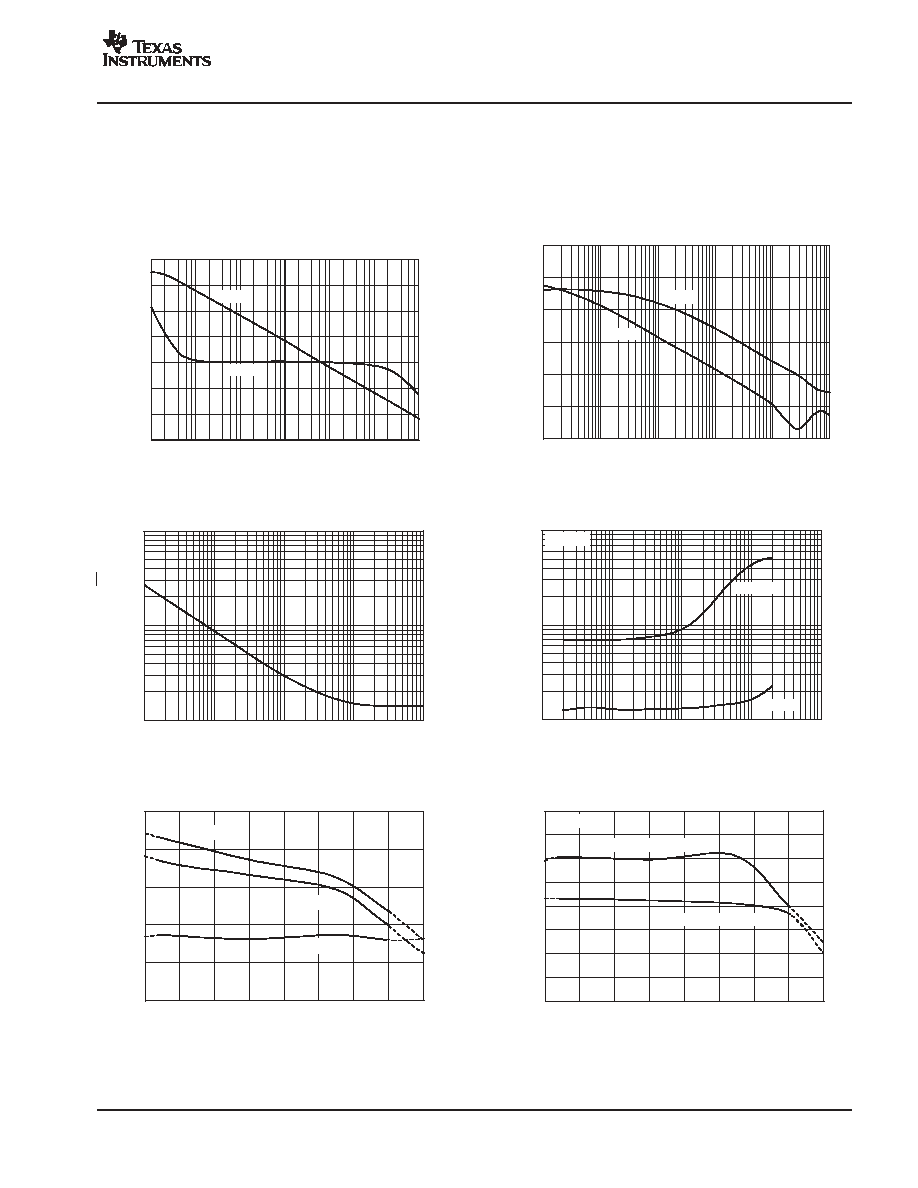
OPA373, OPA2373
OPA374
OPA2374, OPA4374
SBOS279D - SEPTEMBER 2003 - REVISED DECEMBER 2004
www.ti.com
5
TYPICAL CHARACTERISTICS
At TA = +25
∞
C, RL = 10k
connected to VS/2, and VOUT = VS/2, unless otherwise noted.
OPEN-LOOP GAIN AND PHASE vs FREQUENCY
Frequency (Hz)
10
100
1k
10k
100k
1M
10M
120
100
80
60
40
20
0
-
20
30
0
-
30
-
60
-
90
-
120
-
150
-
180
O
p
e
n
-
L
oop
G
a
i
n
(
d
B
)
P
h
as
e
M
ar
g
i
n
(
_
)
Phase
Gain
POWER-SUPPLY AND COMMON-MODE
REJECTION RATIO vs FREQUENCY
Frequency (Hz)
100
1k
10k
100k
1M
10M
120
100
80
60
40
20
0
PSR
R
a
n
d
C
M
R
R
(
d
B)
PSRR
CMRR
INPUT VOLTAGE NOISE
SPECTRAL DENSITY vs FREQUENCY
Frequency (Hz)
10
100
1k
10k
100k
1000
100
10
V
o
l
t
ag
e
N
oi
s
e
(
n
V
/
Hz
)
TOTAL HARMONIC DISTORTION+NOISE
vs FREQUENCY
Frequency (Hz)
10
100
1k
10k
100k
0.100
0.010
0.001
T
o
t
a
l
H
a
r
m
o
n
i
c
D
is
t
o
r
t
io
n
+
N
o
is
e
(
%
)
R
L
= 5k
G = 10V/V
G = 1V/V
OPEN-LOOP GAIN AND POWER-SUPPLY
REJECTION RATIO vs TEMPERATURE
Temperature (
_
C)
-
50
-
25
0
25
50
75
100
125
150
130
120
110
100
90
80
A
OL
,P
S
R
R(
d
B
)
PSRR
R
L
= 5k
R
L
= 100k
COMMON-MODE REJECTION RATIO vs TEMPERATURE
120
110
100
90
80
70
60
50
40
CM
RR
(
d
B
)
Temperature (
_
C)
-
50
-
25
0
25
50
75
100
125
150
V
CM
=
-
0.2V to 3.5V
V
CM
=
-
0.2V to 5.7V
V
S
= 5.5V

OPA373, OPA2373
OPA374
OPA2374, OPA4374
SBOS279D - SEPTEMBER 2003 - REVISED DECEMBER 2004
www.ti.com
6
TYPICAL CHARACTERISTICS (continued)
At TA = +25
∞
C, RL = 10k
connected to VS/2, and VOUT = VS/2, unless otherwise noted.
QUIESCENT CURRENT vs TEMPERATURE
800
700
600
500
400
300
Q
u
i
e
s
c
ent
C
u
r
r
en
t
(
µ
A)
Temperature (
_
C)
-
50
-
25
0
25
50
75
100
125
150
QUIESCENT CURRENT vs SUPPLY VOLTAGE
Supply Voltage (V)
2.0
2.5
3.0
3.5
4.0
4.5
5.0
5.5
800
700
600
500
400
300
Q
u
i
e
s
c
e
n
t
C
ur
r
e
nt
(
µ
A)
V
OUT
= 1/2[(V+)
-
(V
-
)]
SHORT-CIRCUIT CURRENT vs TEMPERATURE
Temperature (
_
C)
-
50
-
25
0
25
50
75
100
125
16
14
12
10
8
6
4
2
0
S
h
o
r
t
-
C
i
r
c
ui
t
C
ur
r
ent
(
m
A
)
+I
SC
-
I
SC
CONTINUOUS SHORT-CIRCUIT CURRENT vs
POWER-SUPPLY VOLTAGE
Power-Supply Voltage (V)
2.0
2.5
3.0
3.5
4.0
4.5
5.0
5.5
12
10
8
6
4
2
0
S
h
or
t
-
C
i
r
c
ui
t
C
ur
r
e
n
t
(
m
A
)
+I
SC
-
I
SC
INPUT BIAS CURRENT vs TEMPERATURE
Temperature (
_
C)
-
50
-
25
0
25
50
75
100
125
10k
1k
100
10
1
0.1
In
p
u
t
B
i
a
s
C
ur
r
ent
(
p
A
)
OUTPUT VOLTAGE SWING vs OUTPUT CURRENT
Output Current (mA)
0
2
4
6
8
10
12
14
16
18
20
3
2
1
0
-
1
-
2
-
3
O
u
tput
V
o
l
t
age
(
V
)
-
55
_
C
25
_
C
150
_
C
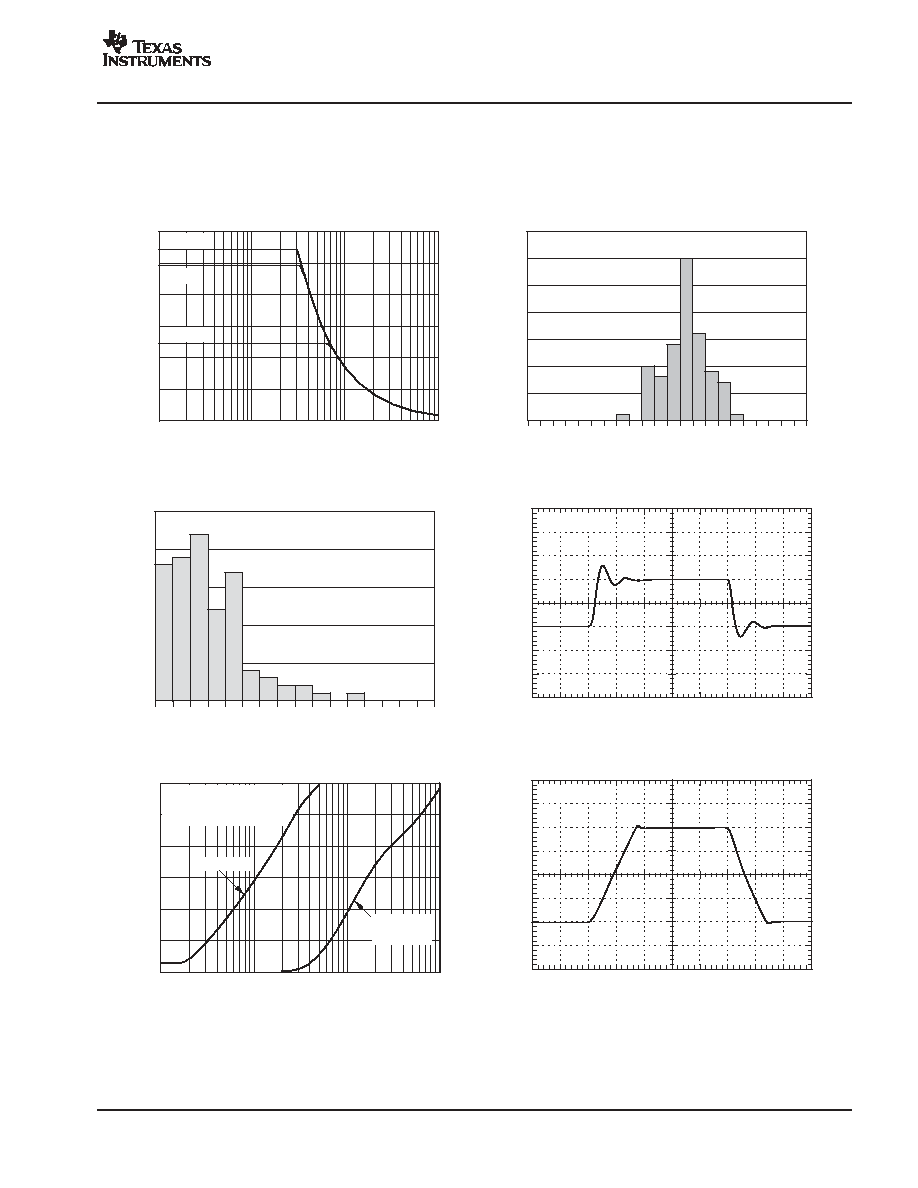
OPA373, OPA2373
OPA374
OPA2374, OPA4374
SBOS279D - SEPTEMBER 2003 - REVISED DECEMBER 2004
www.ti.com
7
TYPICAL CHARACTERISTICS (continued)
At TA = +25
∞
C, RL = 10k
connected to VS/2, and VOUT = VS/2, unless otherwise noted.
MAXIMUM OUTPUT VOLTAGE vs FREQUENCY
Frequency (Hz)
10k
100k
1M
10M
6
5
4
3
2
1
0
Ou
t
p
u
t
V
o
l
t
a
g
e
(
V
PP
)
V
S
= 5.5V
V
S
= 5V
V
S
= 2.5V
OFFSET VOLTAGE PRODUCTION DISTRIBUTION
Offset Voltage (mV)
-
5
-
4
-
3
-
2
-
1
0
1
2
3
4
5 5.5
P
o
pul
a
t
i
o
n
OFFSET VOLTAGE DRIFT MAGNITUDE
PRODUCTION DISTRIBUTION
Offset Voltage Drift (
µ
V/
_
C)
1
2
3
4
5
6
7
8
9 10 11 12 13 14 15 16
P
o
pu
l
a
t
i
on
Typical production distribution
of packaged units.
SMALL-SIGNAL STEP RESPONSE
200ns/div
50m
V
/
di
v
C
L
= 100pF
SMALL-SIGNAL OVERSHOOT vs LOAD CAPACITANCE
Load Capacitance (pF)
10
100
1k
10k
60
50
40
30
20
10
0
Sm
a
l
l-
S
i
gnal
O
v
e
r
s
hoot
(
%
)
G = +1V/V
G =
±
10V/V
R
FB
= 10k
Refer to the Capacitive Load
and Stability section for tips
on improving performance.
LARGE -SIGNAL STEP RESPONSE
400ns/div
1V
/
d
i
v
C
L
= 100pF
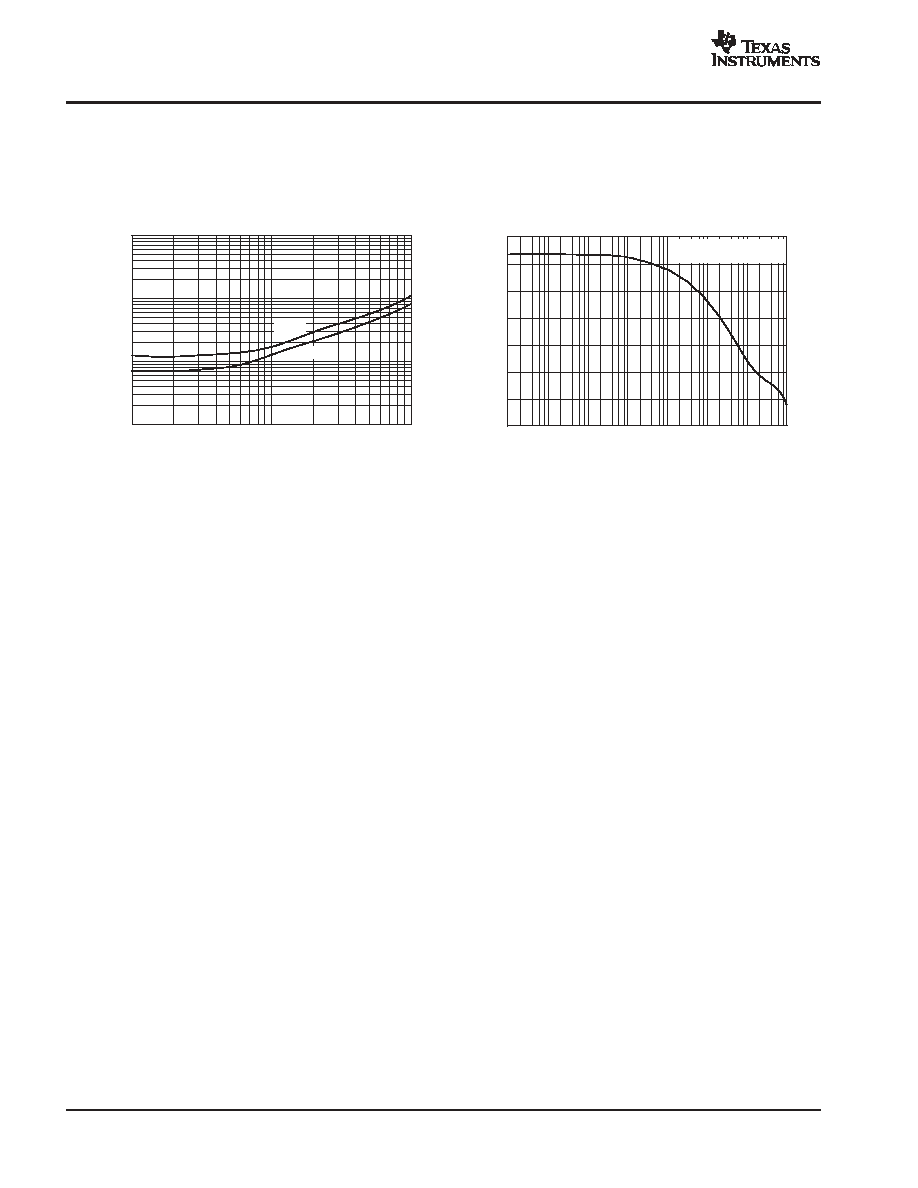
OPA373, OPA2373
OPA374
OPA2374, OPA4374
SBOS279D - SEPTEMBER 2003 - REVISED DECEMBER 2004
www.ti.com
8
TYPICAL CHARACTERISTICS (continued)
At TA = +25
∞
C, RL = 10k
connected to VS/2, and VOUT = VS/2, unless otherwise noted.
SETTLING TIME vs CLOSED-LOOP GAIN
Closed-Loop Gain (V/V)
1
10
100
100
10
1
0.1
Se
t
t
l
i
n
g
T
i
m
e
(
µ
s)
0.01%
0.1%
Frequency (Hz)
C
hann
el
S
epar
at
i
o
n
(
dB
)
140
120
100
80
60
40
20
0
10
100
1K
10K
100K
1M
10M
100M
G = +1V/V, All Channels
CHANNEL SEPARATION vs FREQUENCY
R
L
= 5k
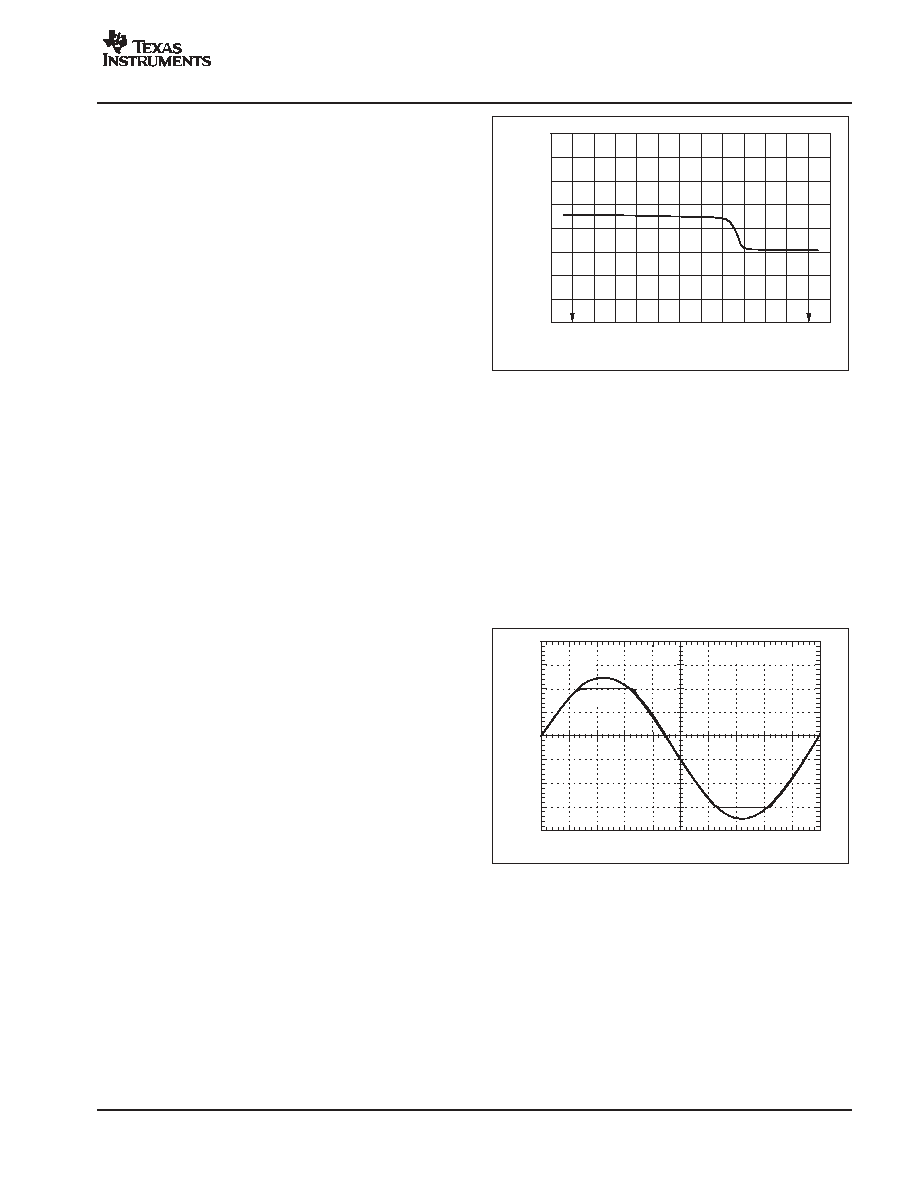
OPA373, OPA2373
OPA374
OPA2374, OPA4374
SBOS279D - SEPTEMBER 2003 - REVISED DECEMBER 2004
www.ti.com
9
APPLICATIONS
The OPA373 and OPA374 series op amps are unity-gain
stable and suitable for a wide range of general-purpose
applications. Rail-to-rail input and output make them ideal
for driving sampling Analog-to-Digital Converters (ADCs).
Excellent AC performance makes them well suited for
audio applications. The class AB output stage is capable
of driving 100k
loads connected to any point between V+
and ground.
The input common-mode voltage range includes both
rails, allowing the OPA373 and OPA374 series op amps to
be used in virtually any single-supply application up to a
supply voltage of +5.5V.
Rail-to-rail input and output swing significantly increases
dynamic range, especially in low-supply applications.
Power-supply pins should be bypassed with 0.01
µ
F
ceramic capacitors.
OPERATING VOLTAGE
The OPA373 and OPA374 op amps are specified and
tested over a power-supply range of +2.7V to +5.5V
(
±
1.35V to
±
2.75V). However, the supply voltage may
range from +2.3V to +5.5V (
±
1.15V to
±
2.75V). Supply
voltages higher than 7.0V (absolute maximum) can
permanently damage the amplifier. Parameters that vary
over supply voltage or temperature are shown in the
Typical Characteristics section of this data sheet.
COMMON-MODE VOLTAGE RANGE
The input common-mode voltage range of the OPA373
and OPA374 series extends 200mV beyond the supply
rails. This is achieved with a complementary input
stage--an N-channel input differential pair in parallel with
a P-channel differential pair. The N-channel pair is active
for input voltages close to the positive rail, typically
(V+) - 1.65V to 200mV above the positive supply, while
the P-channel pair is on for inputs from 200mV below the
negative supply to approximately (V+) - 1.65V. There is a
500mV transition region, typically (V+) - 1.9V to
(V+) - 1.4V, in which both pairs are on. This 500mV
transition region, shown in Figure 1, can vary
±
300mV with
process variation. Thus, the transition region (both stages
on) can range from (V+) - 2.2V to (V+) - 1.7V on the low
end, up to (V+) - 1.6V to (V+) - 1.1V on the high end.
Within the 500mV transition region PSRR, CMRR, offset
voltage, offset drift, and THD may be degraded compared
to operation outside this region.
Common-Mode Voltage (V)
-
0.5
0
0.5
V
-
1.0 1.5
2.0 2.5
3.0
3.5
4.0 4.5 5.0
5.5
6.0
2.0
1.5
1.0
0.5
0
-
0.5
-
1.0
-
1.5
-
2.0
O
ffs
e
t
V
o
l
t
a
g
e
(
m
V
)
V+
Figure 1. Behavior of Typical Transition Region at
Room Temperature
RAIL-TO-RAIL INPUT
The input common-mode range extends from (V-) - 0.2V
to (V+) + 0.2V. For normal operation, inputs should be
limited to this range. The absolute maximum input voltage
is 500mV beyond the supplies. Inputs greater than the
input common-mode range but less than the maximum
input voltage, while not valid, will not cause any damage
to the op amp. Unlike some other op amps, if input current
is limited, the inputs may go beyond the supplies without
phase inversion, as shown in Figure 2.
1V
/
d
i
v
1
µ
s/div
5V
0V
V
IN
V
OUT
G = +1V/V, V
S
= 5V
Figure 2. OPA373: No Phase Inversion with
Inputs Greater Than the Power-Supply Voltage
Normally, input bias current is approximately 500fA;
however, input voltages exceeding the power supplies by
more than 500mV can cause excessive current to flow in
or out of the input pins. Momentary voltages greater than
500mV beyond the power supply can be tolerated if the
current on the input pins is limited to 10mA. This is easily
accomplished with an input resistor; see Figure 3. (Many
input signals are inherently current-limited to less than
10mA, therefore, a limiting resistor is not required.)

OPA373, OPA2373
OPA374
OPA2374, OPA4374
SBOS279D - SEPTEMBER 2003 - REVISED DECEMBER 2004
www.ti.com
10
R
OPA373
V+
V
IN
V
OUT
10mA max
I
OVERLOAD
Figure 3. Input Current Protection for Voltages
Exceeding the Supply Voltage
RAIL-TO-RAIL OUTPUT
A class AB output stage with common-source transistors
is used to achieve rail-to-rail output. For light resistive
loads ( > 100k
), the output voltage can typically swing to
within 18mV from the supply rails. With moderate resistive
loads (5k
to 50k
), the output can typically swing to
within 100mV from the supply rails and maintain high
open-loop gain. See the Typical Characteristics curve,
Output Voltage Swing vs Output Current, for more
information.
CAPACITIVE LOAD AND STABILITY
OPA373 series op amps can drive a wide range of
capacitive loads. However, under certain conditions, all op
amps may become unstable. Op amp configuration, gain,
and load value are just a few of the factors to consider
when determining stability. An op amp in unity-gain
configuration is the most susceptible to the effects of
capacitive load. The capacitive load reacts with the op amp
output resistance, along with any additional load
resistance, to create a pole in the small-signal response
that degrades the phase margin. The OPA373 series op
amps perform well in unity-gain configuration, with a pure
capacitive load up to approximately 250pF. Increased
gains allow the amplifier to drive more capacitance. See
the Typical Characteristics curve, Small-Signal Overshoot
vs Capacitive Load, for further details.
One method of improving capacitive load drive in the
unity-gain configuration is to insert a small (10
to 20
)
resistor, R
S
, in series with the output, as shown in Figure 4.
This significantly reduces ringing while maintaining DC
performance for purely capacitive loads. When there is a
resistive load in parallel with the capacitive load, R
S
must
be placed within the feedback loop as shown to allow the
feedback loop to compensate for the voltage divider
created by R
S
and R
L
.
In unity-gain inverter configuration, phase margin can be
reduced by the reaction between the capacitance at the op
amp input and the gain setting resistors, thus degrading
capacitive load drive. Best performance is achieved by
using small valued resistors. However, when large valued
resistors cannot be avoided, a small (4pF to 6pF)
capacitor, C
FB
, can be inserted in the feedback, as shown
in Figure 5. This significantly reduces overshoot by
compensating the effect of capacitance, C
IN
, which
includes the amplifier input capacitance and PC board
parasitic capacitance.
R
S
10
to 20
OPA373
C
L
R
L
V
IN
V
OUT
V+
Figure 4. Series Resistor in Unity-Gain
Configuration Improves Capacitive Load Drive
R
I
OPA373
V
IN
V
OUT
R
F
C
FB
C
IN
C
L
V+
Figure 5. Improving Capacitive Load Drive
For example, when driving a 100pF load in unity-gain
inverter configuration, adding a 6pF capacitor in parallel
with the 10k
feedback resistor decreases overshoot from
57% to 12%, as shown in Figure 6.
Load Capacitance (pF)
10
100
1k
10k
60
50
40
30
20
10
0
O
v
er
s
h
oo
t
(
%
)
G =
-
1V/V
R
FB
= 10k
C
FB
= 6pF
Figure 6. Improving Capacitive Load Drive

OPA373, OPA2373
OPA374
OPA2374, OPA4374
SBOS279D - SEPTEMBER 2003 - REVISED DECEMBER 2004
www.ti.com
11
DRIVING ADCs
The OPA373 and OPA374 series op amps are optimized
for driving medium-speed sampling ADCs. The OPA373
and OPA374 op amps buffer the ADC input capacitance
and resulting charge injection, while providing signal gain.
The OPA373 is shown driving the ADS7816 in a basic
noninverting configuration, as shown in Figure 7. The
ADS7816 is a 12-bit, MicroPower sampling converter in
the MSOP-8 package. When used with the low-power,
miniature packages of the OPA373, the combination is
ideal for space-limited, low-power applications. In this
configuration, an RC network at the ADC input can be used
to provide anti-aliasing filtering.
Figure 8 shows the OPA373 driving the ADS7816 in a
speech band-pass filtered data acquisition system. This
small, low-cost solution provides the necessary
amplification and signal conditioning to interface directly
with an electret microphone. This circuit will operate with
V
S
= 2.7V to 5V.
The OPA373 is shown in the inverting configuration
described in Figure 9. In this configuration, filtering may be
accomplished with the capacitor across the feedback
resistor.
ENABLE/SHUTDOWN
OPA373 and OPA374 series op amps typically require
585
µ
A quiescent current. The enable/shutdown feature of
the OPA373 allows the op amp to be shut off in order to
reduce this current to less than 1
µ
A.
ADS7816
12-Bit ADC
DCLOCK
D
OUT
CS/SHDN
OPA373
+5V
V
IN
V+
2
+In
3
-
In
V
REF
8
4
GND
Serial
Interface
1
0.1
µ
F
0.1
µ
F
7
6
5
NOTE: ADC Input = 0 to V
REF
V
IN
= 0V to 5V for
0V to 5V output.
RC network filters high frequency noise.
500
3300pF
f
SAMPLE
= 100kHz
Figure 7. The OPA373 in Noninverting Configuration Driving the ADS7816
C
3
33pF
V+
3
1
8
4 GND
5
6
7
-
IN
+IN
2
DCLOCK
Serial
Interface
C
2
1000pF
R
1
1.5k
R
4
20k
R
5
20k
R
6
100k
R
8
150k
R
9
510k
R
7
51k
D
OUT
V
REF
V+ = +2.7V to +5V
CS/SHDN
C
1
1000pF
Electret
Microphone
(1)
G = 100
Passband 300Hz to 3kHz
R
3
1M
R
2
1M
NOTE: (1) Electret microphone
powered by R
1
.
ADS7816
12-Bit ADC
1/2
OPA2373
1/2
OPA2373
Figure 8. The OPA2373 as a Speech Bypass Filtered Data Acquisition System

OPA373, OPA2373
OPA374
OPA2374, OPA4374
SBOS279D - SEPTEMBER 2003 - REVISED DECEMBER 2004
www.ti.com
12
ADS7816
12- Bit ADC
DCLOCK
D
OUT
CS/SHDN
OPA373
+5V
V
IN
V+
2
+IN
3
-
IN
V
REF
8
4
GND
Serial
Interface
1
0.1
µ
F
0.1
µ
F
7
6
5
NOTE: ADC Input = 0 to V
REF
5k
5k
330pF
500k
3300pF
V
S
2
Figure 9. The OPA373 in Inverting Configuration Driving the ADS7816
NOTE: FilterPro is a low-pass filter design program available for download at
no cost from TI's web site (www.ti.com). The program can be used to determine
component values for other cutoff frequencies or filter types.
1/2
OPA373
R
1
11.7k
330pF
C
1
680pF
R
2
2.72k
1/2
OPA373
C
2
330pF
R
3
21.4k
C
3
Figure 10. Three-Pole Sallen-Key Butterworth Low-Pass Filter
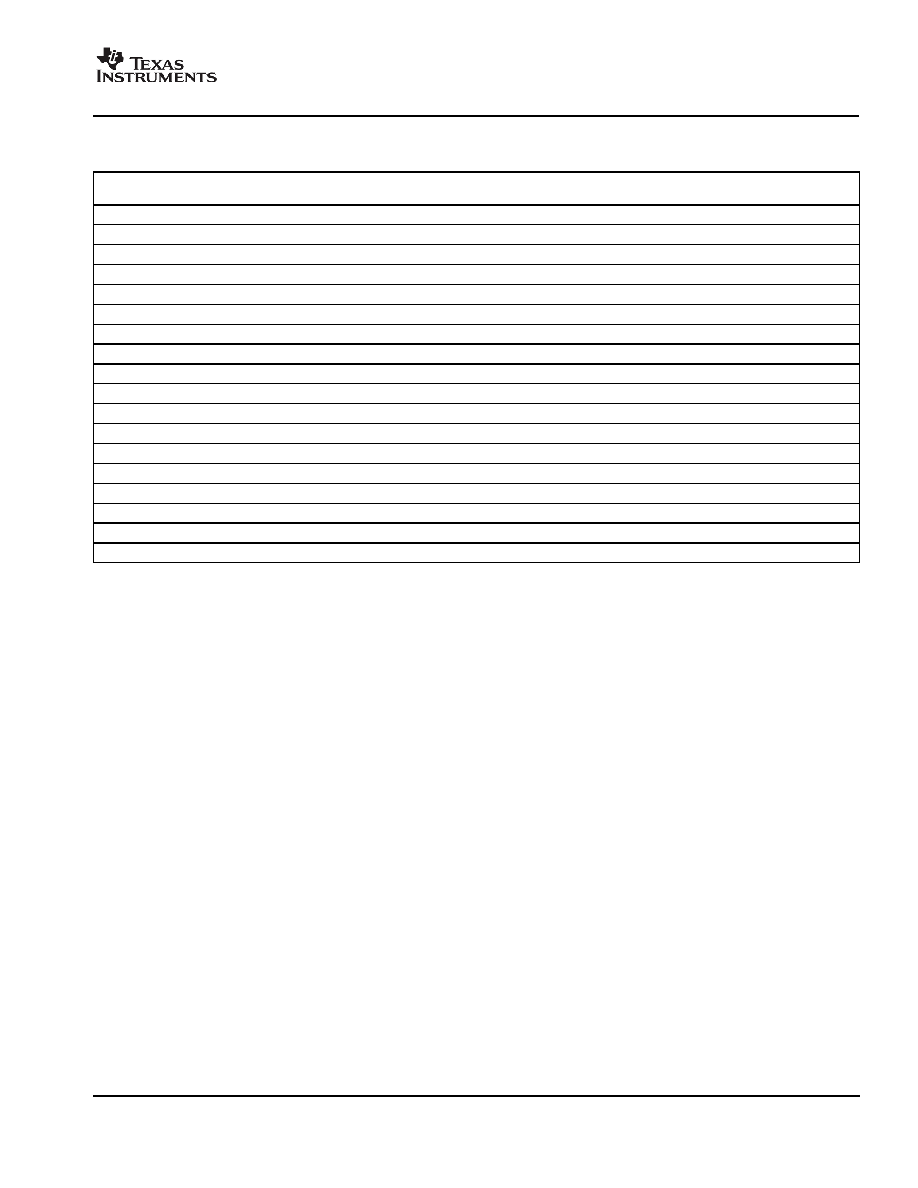
PACKAGING INFORMATION
Orderable Device
Status
(1)
Package
Type
Package
Drawing
Pins Package
Qty
Eco Plan
(2)
Lead/Ball Finish
MSL Peak Temp
(3)
OPA2373AIDGSR
ACTIVE
MSOP
DGS
10
3000
None
CU NIPDAU
Level-3-235C-168 HR
OPA2373AIDGST
ACTIVE
MSOP
DGS
10
250
None
CU NIPDAU
Level-3-235C-168 HR
OPA2374AID
ACTIVE
SOIC
D
8
100
None
CU SNPB
Level-1-240C-UNLIM
OPA2374AIDCNR
ACTIVE
SOT23
DCN
8
3000
None
CU SNPB
Level-3-220C-168 HR
OPA2374AIDCNT
ACTIVE
SOT23
DCN
8
250
None
CU SNPB
Level-3-220C-168 HR
OPA2374AIDR
ACTIVE
SOIC
D
8
2500
None
CU SNPB
Level-1-240C-UNLIM
OPA373AID
ACTIVE
SOIC
D
8
100
None
CU SNPB
Level-1-240C-UNLIM
OPA373AIDBVR
ACTIVE
SOT-23
DBV
6
3000
None
CU NIPDAU
Level-3-250C-168 HR
OPA373AIDBVT
ACTIVE
SOT-23
DBV
6
250
None
CU NIPDAU
Level-3-250C-168 HR
OPA373AIDR
ACTIVE
SOIC
D
8
2500
None
CU SNPB
Level-1-240C-UNLIM
OPA374AID
ACTIVE
SOIC
D
8
100
None
CU SNPB
Level-1-220C-UNLIM
OPA374AIDBVR
ACTIVE
SOT-23
DBV
5
3000
None
CU NIPDAU
Level-3-250C-168 HR
OPA374AIDBVT
ACTIVE
SOT-23
DBV
5
250
None
CU NIPDAU
Level-3-250C-168 HR
OPA374AIDR
ACTIVE
SOIC
D
8
2500
None
CU SNPB
Level-1-220C-UNLIM
OPA4374AID
ACTIVE
SOIC
D
14
58
None
CU SNPB
Level-1-220C-UNLIM
OPA4374AIDR
ACTIVE
SOIC
D
14
2500
None
CU SNPB
Level-1-220C-UNLIM
OPA4374AIPWR
ACTIVE
TSSOP
PW
14
2500
None
CU SNPB
Level-1-220C-UNLIM
OPA4374AIPWT
ACTIVE
TSSOP
PW
14
250
None
CU SNPB
Level-1-220C-UNLIM
(1)
The marketing status values are defined as follows:
ACTIVE: Product device recommended for new designs.
LIFEBUY: TI has announced that the device will be discontinued, and a lifetime-buy period is in effect.
NRND: Not recommended for new designs. Device is in production to support existing customers, but TI does not recommend using this part in
a new design.
PREVIEW: Device has been announced but is not in production. Samples may or may not be available.
OBSOLETE: TI has discontinued the production of the device.
(2)
Eco Plan - May not be currently available - please check
http://www.ti.com/productcontent
for the latest availability information and additional
product content details.
None: Not yet available Lead (Pb-Free).
Pb-Free (RoHS): TI's terms "Lead-Free" or "Pb-Free" mean semiconductor products that are compatible with the current RoHS requirements
for all 6 substances, including the requirement that lead not exceed 0.1% by weight in homogeneous materials. Where designed to be soldered
at high temperatures, TI Pb-Free products are suitable for use in specified lead-free processes.
Green (RoHS & no Sb/Br): TI defines "Green" to mean "Pb-Free" and in addition, uses package materials that do not contain halogens,
including bromine (Br) or antimony (Sb) above 0.1% of total product weight.
(3)
MSL, Peak Temp. -- The Moisture Sensitivity Level rating according to the JEDECindustry standard classifications, and peak solder
temperature.
Important Information and Disclaimer:The information provided on this page represents TI's knowledge and belief as of the date that it is
provided. TI bases its knowledge and belief on information provided by third parties, and makes no representation or warranty as to the
accuracy of such information. Efforts are underway to better integrate information from third parties. TI has taken and continues to take
reasonable steps to provide representative and accurate information but may not have conducted destructive testing or chemical analysis on
incoming materials and chemicals. TI and TI suppliers consider certain information to be proprietary, and thus CAS numbers and other limited
information may not be available for release.
In no event shall TI's liability arising out of such information exceed the total purchase price of the TI part(s) at issue in this document sold by TI
to Customer on an annual basis.
PACKAGE OPTION ADDENDUM
www.ti.com
16-Dec-2004
Addendum-Page 1


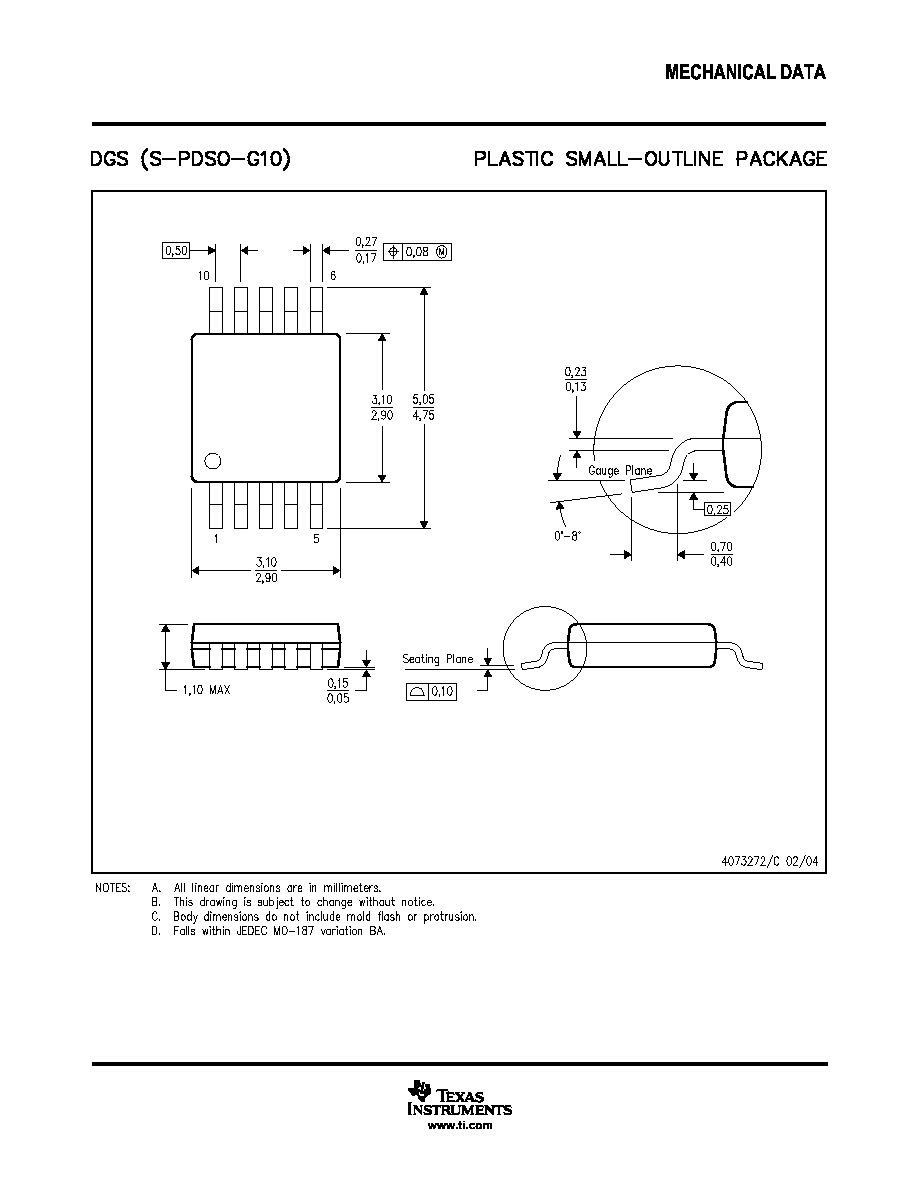

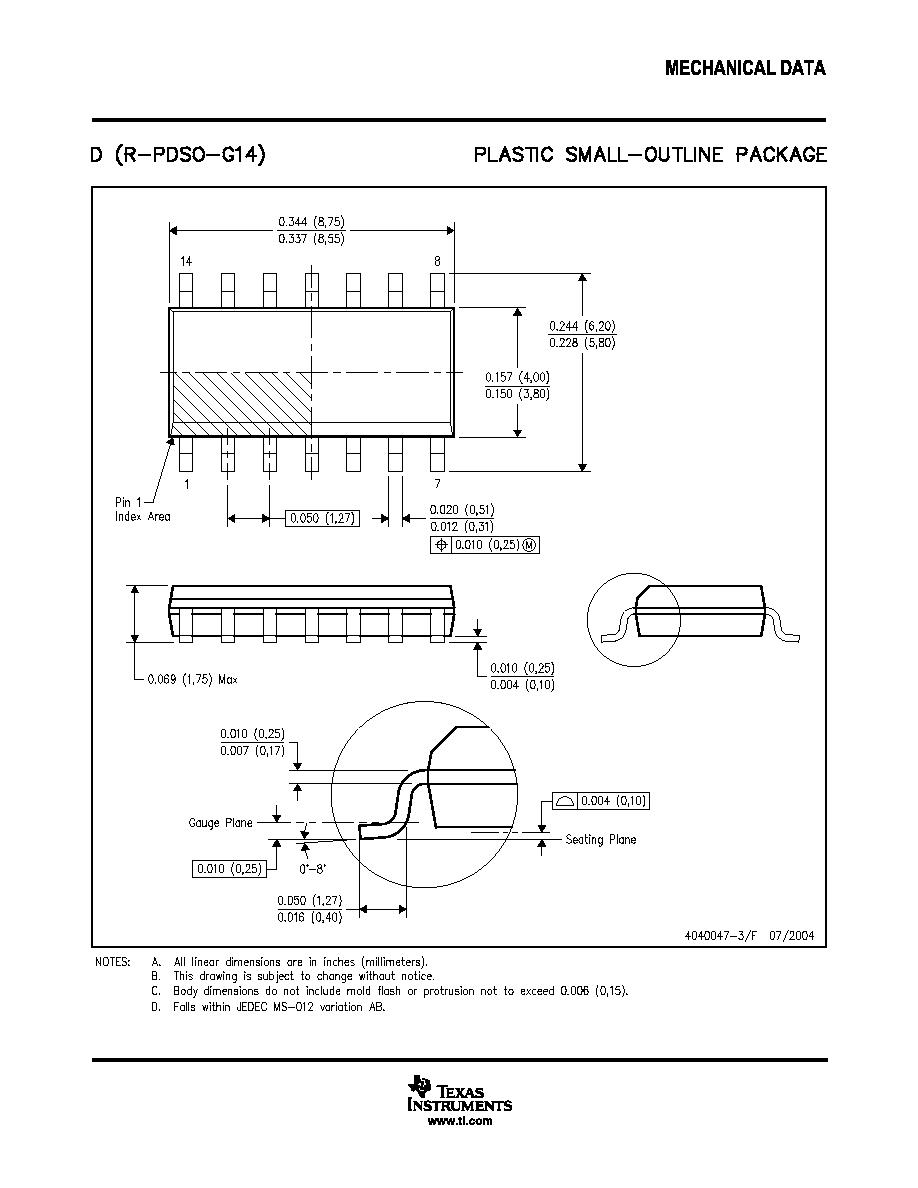

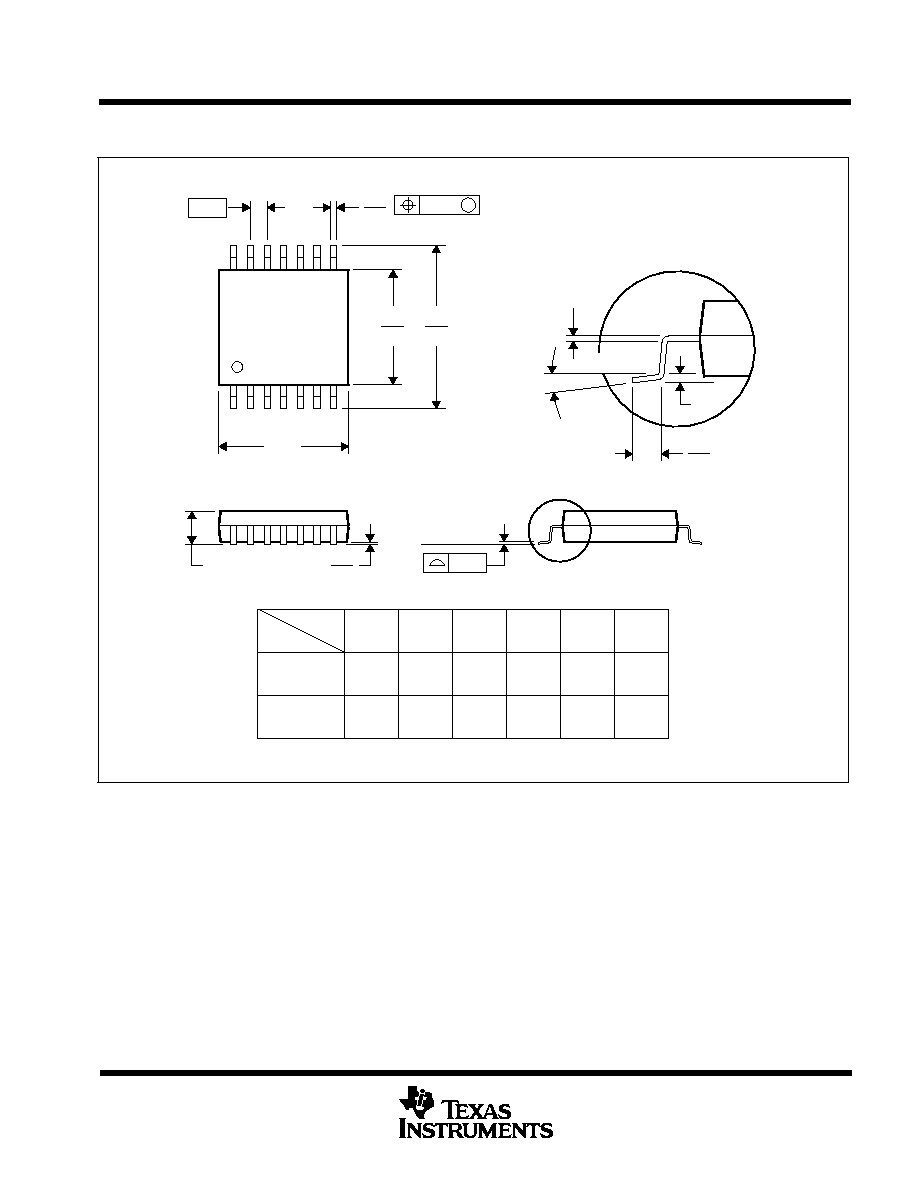
MECHANICAL DATA
MTSS001C ≠ JANUARY 1995 ≠ REVISED FEBRUARY 1999
POST OFFICE BOX 655303
∑
DALLAS, TEXAS 75265
PW (R-PDSO-G**)
PLASTIC SMALL-OUTLINE PACKAGE
14 PINS SHOWN
0,65
M
0,10
0,10
0,25
0,50
0,75
0,15 NOM
Gage Plane
28
9,80
9,60
24
7,90
7,70
20
16
6,60
6,40
4040064/F 01/97
0,30
6,60
6,20
8
0,19
4,30
4,50
7
0,15
14
A
1
1,20 MAX
14
5,10
4,90
8
3,10
2,90
A MAX
A MIN
DIM
PINS **
0,05
4,90
5,10
Seating Plane
0
∞
≠ 8
∞
NOTES: A. All linear dimensions are in millimeters.
B. This drawing is subject to change without notice.
C. Body dimensions do not include mold flash or protrusion not to exceed 0,15.
D. Falls within JEDEC MO-153

IMPORTANT NOTICE
Texas Instruments Incorporated and its subsidiaries (TI) reserve the right to make corrections, modifications,
enhancements, improvements, and other changes to its products and services at any time and to discontinue
any product or service without notice. Customers should obtain the latest relevant information before placing
orders and should verify that such information is current and complete. All products are sold subject to TI's terms
and conditions of sale supplied at the time of order acknowledgment.
TI warrants performance of its hardware products to the specifications applicable at the time of sale in
accordance with TI's standard warranty. Testing and other quality control techniques are used to the extent TI
deems necessary to support this warranty. Except where mandated by government requirements, testing of all
parameters of each product is not necessarily performed.
TI assumes no liability for applications assistance or customer product design. Customers are responsible for
their products and applications using TI components. To minimize the risks associated with customer products
and applications, customers should provide adequate design and operating safeguards.
TI does not warrant or represent that any license, either express or implied, is granted under any TI patent right,
copyright, mask work right, or other TI intellectual property right relating to any combination, machine, or process
in which TI products or services are used. Information published by TI regarding third-party products or services
does not constitute a license from TI to use such products or services or a warranty or endorsement thereof.
Use of such information may require a license from a third party under the patents or other intellectual property
of the third party, or a license from TI under the patents or other intellectual property of TI.
Reproduction of information in TI data books or data sheets is permissible only if reproduction is without
alteration and is accompanied by all associated warranties, conditions, limitations, and notices. Reproduction
of this information with alteration is an unfair and deceptive business practice. TI is not responsible or liable for
such altered documentation.
Resale of TI products or services with statements different from or beyond the parameters stated by TI for that
product or service voids all express and any implied warranties for the associated TI product or service and
is an unfair and deceptive business practice. TI is not responsible or liable for any such statements.
Following are URLs where you can obtain information on other Texas Instruments products and application
solutions:
Products
Applications
Amplifiers
amplifier.ti.com
Audio
www.ti.com/audio
Data Converters
dataconverter.ti.com
Automotive
www.ti.com/automotive
DSP
dsp.ti.com
Broadband
www.ti.com/broadband
Interface
interface.ti.com
Digital Control
www.ti.com/digitalcontrol
Logic
logic.ti.com
Military
www.ti.com/military
Power Mgmt
power.ti.com
Optical Networking
www.ti.com/opticalnetwork
Microcontrollers
microcontroller.ti.com
Security
www.ti.com/security
Telephony
www.ti.com/telephony
Video & Imaging
www.ti.com/video
Wireless
www.ti.com/wireless
Mailing Address:
Texas Instruments
Post Office Box 655303 Dallas, Texas 75265
Copyright
2004, Texas Instruments Incorporated




















